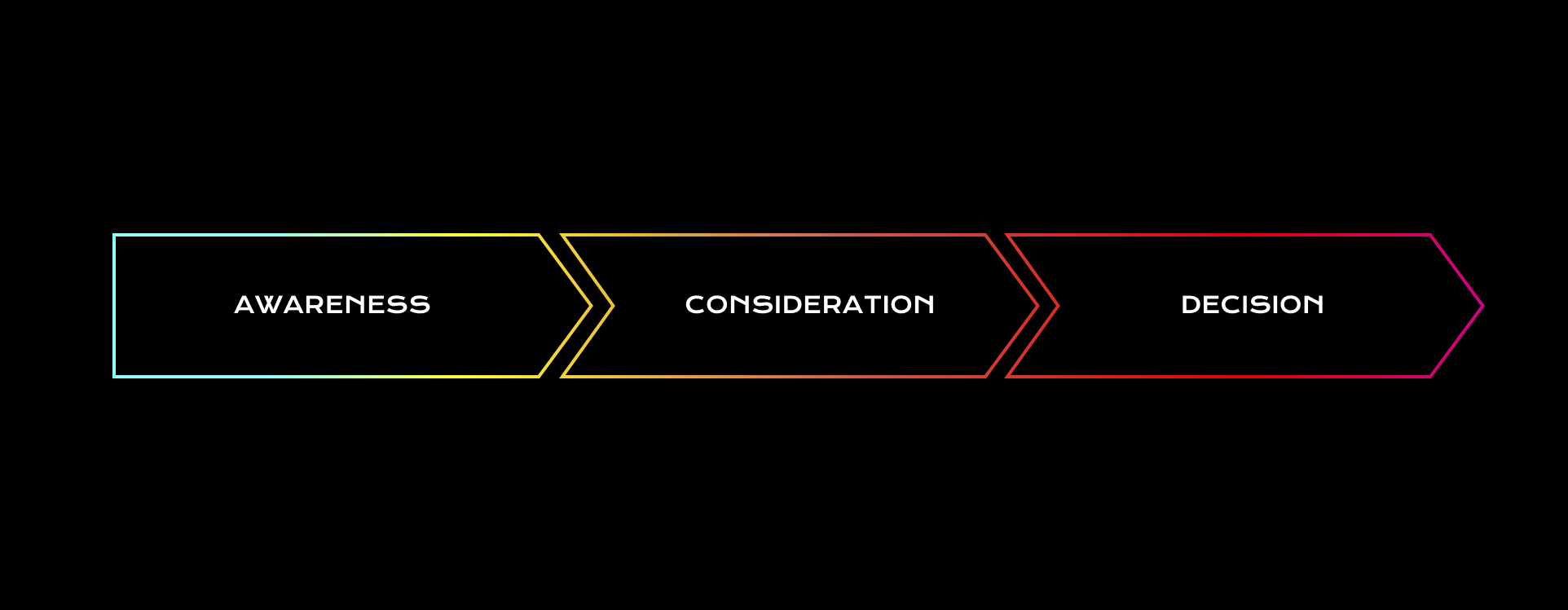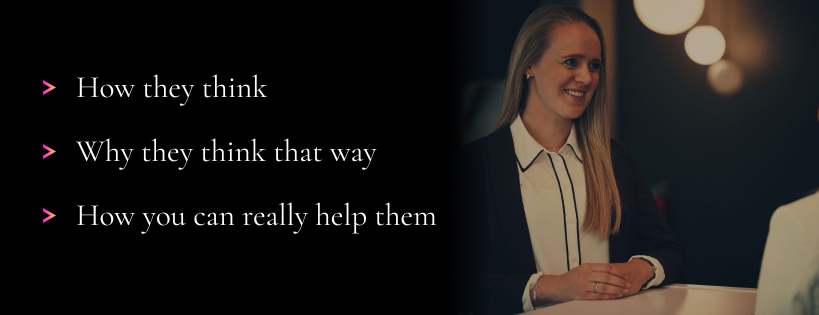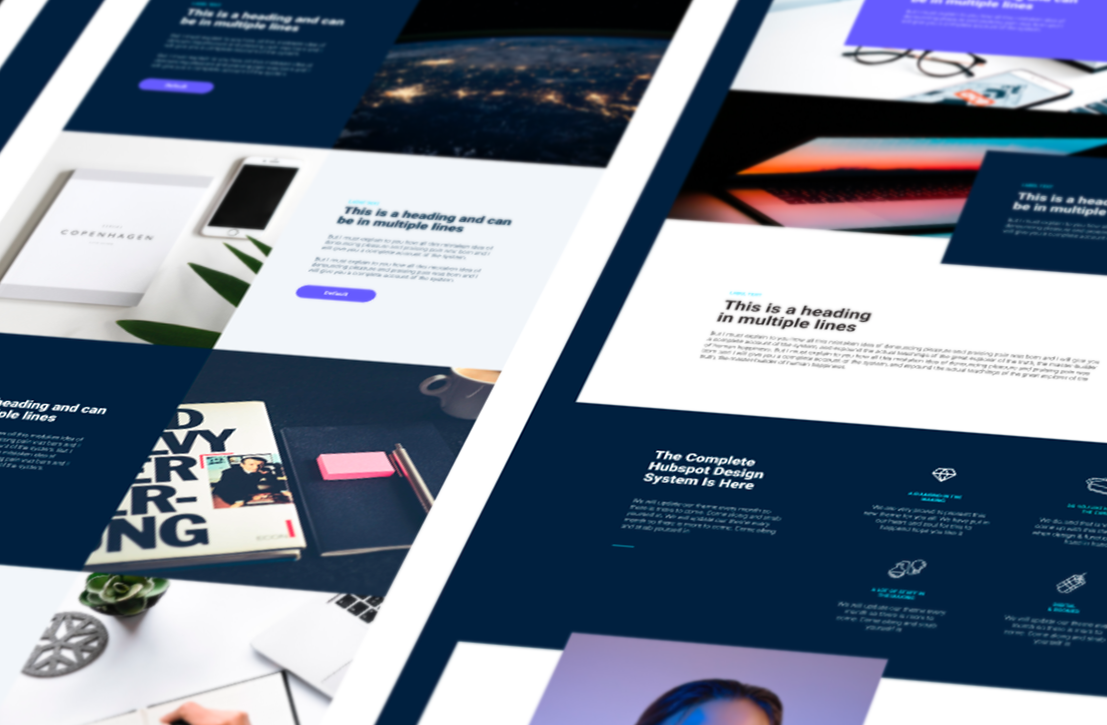THE ULTIMATE GUIDE TO
Content Marketing
Introduction
In this guide we will focus on content in general and content marketing in particular. Many companies struggle to get started creating content, especially at a time when a lot is happening digitally. Therefore, we hope after reading this guide, you’ll feel that you have a better understanding of content marketing and feel inspired to get started with your own content production. Or have enough knowledge to boost your existing content.
In addition to a detailed explanation of content marketing as a method, we also explain the buyer's journey and what content can look like in its different phases. Why is it so important for companies to find and focus more on their target group and the visitor, rather than on themselves? Last but not least, some examples of channels to create content for and practical tips on writing better content.
1. What is content marketing?
Today, there are many ways for companies to market themselves, but no matter what format or channel you are in, you need content. The content that your company creates and publishes can even make the final difference between getting a new customer or not. It may sound unbelievable, but that's actually how it works and we hope you will have a better understanding of how and why after you’ve read this guide.
As previously mentioned, many companies find it difficult to get started creating content. Who should write what? What are you going to write about? And how do you manage to stand out in the noise of today's enormous flow of information? Content marketing answers all these questions, if it’s done right. I will start by taking a closer look at content marketing as a method, especially how you can provide your visitors, leads and prospects with valuable information.
Depending on where a person is in their buyer's journey, they will be interested in different types of content. To explain it all more clearly, we will share a common example of what content in the various phases of the buyer's journey can look like.
Content in the different phases of the buyer's journey
In inbound marketing, Avidly work with companies to help them identify their buyer personas (the dream customer) and their customer’s buying journeys. We use content marketing as a method to create content for this dream customer which is always based on that customer's buyer's journey, as that journey exists regardless if you work according to inbound or not.
At first, when a customer is facing a challenge, a problem, or having a question, a google search will usually be quite generic. The searches often look like "What is XYZ", "Why XYZ?", "The benefits of XYZ" and so on. At this stage it’s a matter of gaining knowledge about a product or service before the customer is even close to being ready to actually make a purchase or final decision. Let's look at a concrete example on the next page.

Examples of buyer's journey
Assuming that a company struggles getting traffic to their website, the buyer's journey starts with a first google search. It could be something like "how can I drive more traffic to my website?" After a bit of research, the searching person (customer) finds information about companies that, for example, write blogs with relevant content to successfully drive leads to their website. The searching customer becomes curious and wants to find out more about how a company blog works, why they should have a blog and what the benefits are.
The next search in the buyer's journey will be something similar to "blog for companies?”. The results showing will most likely be information about content marketing and what that entails. The customer now becomes curious about content marketing and wants to know more specifics and perhaps searches for “what is content marketing?”. And suddenly the person ended up on this guide.
When they have informed themselves further, through other companies' content, and feel somewhat educated on the subject, it is time to take the next step in the buyer’s journey. Now the search usually changes character, to something much more solution oriented. It's now about finding concrete tips on how to move forward, how to create content in the best way. “The 10 best tips for a successful corporate blog”, and so on.
Eventually, when the person feels confident enough about what the best method or solution to their particular needs are, they often realise that they need help with this.

The next, and often final google search can therefore be something like; "supplier content marketing" or "agency content marketing". By now the person is ready and interested in reading about a specific company, a case, or getting a demo to understand why they should choose a specific supplier.
So, during the buyer's journey leading up to this, you should focus on creating content that attracts and educates your target audience. Giving them content that answers their questions and needs, which help and inform them in making the best decisions. It’s about helping the customer early on in their buyer's journey, becoming aware of their problem and offering a solution to it. Most companies today are still “self-centred” and only focusing on having content based on what they offer - pure sales. It’s an ineffective way of reaching customers and it doesn’t help you to stand out from the crowd. Instead, make sure you meet your customers right at the beginning of their buyer's journey and provide them with information, knowledge and valuable content all the way through and you’ll have a client that knows your company will be their best partner.
The example above is a general buyer's journey, which we use as a starting point when creating our buyer persona journey. However, it is important to remember that far from all buyer journeys are straightforward or exactly like one another. Some people already have full control over what methods are available and what they need help with, so they google directly on companies that can help. But it is impossible to know exactly who these are, and I would say that the majority of your customers have already gone through a buyer's journey and not contacted the first best company that showed up on google. With valuable and interesting content that you know your potential customers are looking for and appreciating, I promise you will have a strong advantage over your competitors who have not yet realized the great benefits of content marketing.
2. What is "valuable" content?
People often look confused when we talk about "valuable content". Understandable because it is not so simple. It easily becomes a misconception when we talk about "valuable". We automatically think that it's about finding the perfect answer to the question "What is the meaning of life?".... You know, that kind of value. But it could just as easily be something small like answering a simple question. If we return to the previous examples, we assure you that the visitor who ended up on our content marketing post actually got an answer to their question after reading it, or felt more educated about the area. Which was probably the goal of the search; that was the value, and it does not really have to be more difficult than that.
Changed buying behaviour (and Google) requires other methods than before
Now that we have taken a closer look at content marketing as a method and how the content can look in different steps in the buyer’s journey, we should instead focus on why content marketing as a method is so effective. What exactly is the reason this works better today, than spreading the message about how good you are on your entire website? Which worked fine before.
The way we make purchases has changed enormously in recent years, I do not think anyone has missed that. Whether it is a pair of shoes, a picture or a CMS platform for the company, we start by doing research online. We no longer go to the car dealer who says "I have X thousands to spend, what do you have?" and rely on the seller's expertise. With simple means, we can now become as much experts as the seller, thanks to the internet and digitalisation. Therefore, today it is more about sellers needing to inform, help, train a potential customer to make the right purchasing decision. Instead of trying to sell in the same way as 10-15 years ago.
The power us consumers have today of becoming experts ourselves, makes traditional marketing less effective. When we feel compelled to buy something, we find the information we want by ourselves, without the help of sellers. At least for a start. We do not respond to a sales email from a company that wants to sell vacuum cleaners, especially if we are not a bit interested in a vacuum cleaner at the moment. Maybe I bought one yesterday? Most people are simply tired of traditional advertising and want to do both research and purchase on their own terms. Around the clock if desired.
This changed buying behavior, in combination with the incredible amount of content that is produced and published every day, sets high demands on companies to deliver premium quality content that ranks high in search engines. But not only that, today we are picky and have no patience when it comes to getting answers to our questions.
This is another reason why it is so important that all content you create is relevant to your target audience and gives the reader value. In just a few seconds, we can now scroll on to the next web that gives us a better answer, in the worst case, it is to your competitor's site...
In short, nowadays your visitors and potential customers are looking for a lot of information themselves, to be able to make a purchase decision. Therefore, you need to help, inform, educate and create a relationship with your users when they visit you online. Create trust in your company through the content and marketing that users need and want - not to provide them with ads and tired, screaming messages that instead risk having the opposite effect. Preferably also with a personal touch, as it appeals to most of us more than automated emails that feel like spam.
Increased trust results in better (more?) business
What about the business then? How can companies acquire more customers if they shift their focus from traditional sales to help? Is it even possible to sell without obstinate sellers with thousands of products to offer? Yes, it is! It even works great in many cases. Increased trust is built by relevant and interesting content that will ensure you more customers and better client relationships. It's not about traditional sales, content marketing is sales based on creating content that gives your business a stronger online presence and strengthening your brand by staying top of mind with your target audience. This is harder to achieve than you may think. We even dare to say that a company that successfully informs and educates its customers about their decisions will acquire more business than a competitor who sells vacuum cleaners by sending traditional irrelevant (and irritating) newsletters and emails.
Imagine you are looking to buy a product and through your entire buyer's journey, with every google search you perform, you are met by one or two companies that answers your specific questions with relevant articles, webinars and other content, it's safe to say these two companies will be top of mind when making the final decision rather than the results of the companies on page 40 in your search who doesn't manage to answer any of your questions.
The increased trust in your company that really good and relevant content can provide, will ultimately give you more customers. Even though it is not in the long run about traditional sales. In fact, half the point of content marketing is to do just that, to create a stronger brand through the company's content, a relationship with its customers online and become "top of mind" with its target group. I dare to promise that the company that succeeds in this, which helps its potential customers towards a purchase by educating and informing, will ultimately get more customers than the company that sells vacuum cleaners with the help of totally irrelevant sales emails.
Imagine yourself, if you are going to make a purchase and throughout your shopping trip, at more or less every googling one or two specific companies popped up with articles, webinars or other content that answers your questions in minutes.
It is quite logical that these companies will in the end have a big advantage over the companies that are still lying on page 40 in the search results, and do not answer a single one of the target group's questions. With your hand on your heart, which company would you choose?
3. How do you create content that your audience will love?
We have discussed the foundations of “what” and “why” which are the theoretical parts behind content marketing. Let's move on to the “how” and the more practical blocks of creating content. Firstly, content marketing should be used in more channels than just one. Use it as a powerful strategy throughout your company's online presence. If you want to invest in meaningful content that enables your customers to make relevant purchases we advise a 80%-20% set up. 80% of which is talking with/about the customer and 20% about yourself (pretty much like a successful mingle at a party.)
In the same way, businesses should start to think like this when it comes to telling about themselves, in general less focus on you and your products / services, more focus on the buyer personas and their challenges. Today, in this digital era there are several platforms / channels that need to be filled with content but it is important to remember that different personas / targets are in different places. On your website, the main goal is to share information about your business, how you or your products can help your potential customers with their questions.
On social media, e.g Facebook and Instagram, often it is more about employer branding or sharing inspirational, relevant content. Here is a list of the main channels I think business should use. I can not say that I have the perfect recipe for exactly what to write in each channel, since every business is different and has different target audiences.
Website
A website is today many businesses main sales channel. Therefore it's very important your website is always up to date and has content which answers the visitors questions quickly. For example, content such as links to cases, services, prices and “about us” are things that are often appreciated on a front page. Preferably, the content should also let the visitor know early where he is and what your company is doing.
It is important here to still have your customers' needs in mind. The point is not to brag about yourself, you just need to be clear how and what you can help them with. In a way they are enticed by, not in a way to brag.
If you want to take your website to the next level you can use platforms, e.g HubSpot to make smart content. Smart content is when your content on the website changes depending on who is visiting the site. For example, if a visitor is an unknown contact for you, he or she will see general content when visiting your site for the first time. Or, if you already have a contact which before has shown interest in content marketing, he or she will get other relevant suggestions on content that can be relevant and interesting. This will give the visitor a smooth, personalised and seamless user experience.

Social media
Many businesses still see social media as something for private use. Platforms for cute kittens, funny memes and other stuff you can gladly put hours of scrolling into. But social media platforms are today perfect channels for marketing, not only for B2C.
Statistics show 75 % of buyers are using social media in their buyer's journey. Other numbers show that sales people who invest time in social media reach their budget, compared to 49 % of those who are not on social media. In this guide we are focusing on the content but in this case the numbers are speaking a lot about how important and impactful social media can be.
First of all, find out which social media platforms your target audience / buyer personas are using. You can get this information by creating a buyer persona or performing a target audience analysis. Depending on the answers, you will know where to put your largest focus to be able to reach them.
One important thing with content in social media is to remember you have only a few seconds to attract the reader. Therefore, don't be afraid to use messages and texts which gets the reader to react, something that will quickly get the reader engaged.
In general, we would say LinkedIn is the best platform to generate more leads and to be able to easily pinpoint a specific profession you want to reach. Use this as a starting point and from here you can plan the content you think will attract your target audience.
Facebook and Instagram can of course also be great platforms to reach potential clients on, but in general B2C is still bigger than B2B here.

In inbound marketing we work a lot with marketing automation. Here you have a lot of opportunities to provide your customers and potential customers with the right content, at the right time in their buyer's journey. Personalised and easy. By keeping track of what they are reading and downloading on your website (all this kind of information will be collected on the contact card in HubSpot) you know how the potential client is handling their buying process. A few days after a prospect has downloaded premium content about inbound marketing (example) on your website, you can send them an email with recommendations on more content related to the same subject.
This process is built in a workflow, which basically handles itself when the emails are created. In the meantime you make sure you always provide the potential client with relevant content and a smooth user experience through their buyer's journey. And at the same time, the potential buyer will get increased trust in your company - win-win!
Video
Video as a format has exploded in recent years. Video has for a long time now been the most superior format when it comes to showing how products are working, since many prefer video when teaching something new or want to know how a product works. There are also statistics that show video is what is easiest for us to remember, since it's more visual than just text.
Above are just a few reasons why businesses should start using more in their marketing. To share an example, in Sweden we created this short video with the title “This is how it is to work in Avidly”. The video was really appreciated and got a large reach in Sweden, which strengthened our brand and made people curious about working at our office. In addition to this, we also got several applications for open positions after the video.
80 % of video marketers claim that video has directly increased sales. Wyozl, 2020.

4. A blog? For a business?
A blog is for influencers to write about fashion, daily life and their perfect dress babies, right? Many still think of a blog like this and therefore they don't even think of starting a company blog. A blog is a perfect way to share knowledge and information. Statistics show that businesses who blog have 67 % more leads than businesses who don't.
If you think about it, it is pretty logical. Let's say you have been blogging continuously in 1-2 years and at least published 1 blog post per month. Each blog post is one new page with the potential to rank high on google. If you have optimized it for search engines… These blog posts can attract new traffic a long time after they have been published.
Your blog is a great place for you to create content which focuses on your target audience and their challenges, compared to on the website which can be at least a little bit more about your services and products. Content Marketing is a long term strategy, not a quick fix over a night. By creating and publishing new, fresh and relevant content during a long time you will step by step build a knowledge base which will drive traffic to your page.
One part of a content specialists work in Avidly is to perform SEO analysis, internally and externally for our clients. It is always fun to see when several blog posts are the pages that drive the most traffic to a website, organic traffic via Google. The same goes for us at Avidly, more than 6 out of 10 top pages which drive the most traffic are blog posts. Therefore we know for sure that blogging works for businesses. It's more about learning how to create the right content and how your target audience is looking for information.
And last but not least, if you feel a little bit unsure of calling it a blog, you can choose to just call it knowledgebase or inspiration. Each business is unique and you need to choose what feels right for you, your services and your audiences.

Premium content
To be able to generate leads online you need to make it easy for your visitors (not forgetting that some visitors are potential clients) to convert. On their own terms, not by spamming them with 100 emails per week about a fantastic offer they can not afford to miss and they will only sign up to get rid of you.
To make it easy for the visitor to convert and for your business to gather information about the potential lead on their contact card, you need to provide them with something that is useful enough for them to feel comfortable with sharing their contact information, such as email address.
We call our downloadable content premium content and it comes in many shapes. This guide is one great example of premium content. A longer piece with a lot of useful information to you who are interested in content marketing. It can also be access to a pillar page, a report, a webinar, a research report, a test or a video. The list can be long. Everything is about providing your audience relevant, trustworthy and useful content.
Which kind of content the visitors are interested in differs a lot depending who they are, which role they have at work and of course which company they work for. But we are sure you know that by now! And don´t forget, the possibilities are almost endless with content today.
4. Practical tips - create better content
Let us continue to the more practical part of this guide. We fully understand that content production can feel a little bit overwhelmed in the beginning. Where to start? What to write? Who to aim it at? Take a deep breath and remain calm, we will share our best tips on how to think when getting started with content marketing.
Buyer persona / target audience
A buyer persona is a semi fictional representation of your company's ideal customer. At Avidly we usually create those personas through workshops, interviews and research. This persona is also possible to bring out in a traditional target audience analysis. By getting to know this person it's easier for you to create content which answers their questions and helps them solve their challenges.
Considering how important relevance is today, at least you must have some idea on what your buyer personas are searching for. Otherwise your content risks to be spralling, a wild chance that a potential client finds your website, your blog posts or posts on social media. Can be risky, or even a waste of time in content production if you will.

3 steps to get a clearer understanding of your buyer personas
A buyer persona can be as detailed as you want it to be but in this case I will share a tip to create an easier version. A version any business should be able to create without too much resources. Most of the time, many people in the company have a lot of information about your clients, their needs and their challenges. The hard part here is to get them to share this information with you.
1. Have a workshop with the ones who are seeing the clients the most
Invite marketing, sales reps, support and others from different departments that have a lot of contact with the clients. These are the ones that know them best, what their challenges are and what they are looking for when they search for a product or a service. Sit down together and discuss who your persona or personas can be. Our recommendation in general is to start creating two buyer personas, one decision maker and one influencer. These questions are examples and feel free to adapt them to your business and your buyer personas.
Examples on things to discuss:
- What engages the decision makers / influencers?
- Which challenges do the decision makers / influencers struggle with?
- What can help decision makers with the decision for a purchase?
- What can make the decision maker back out from a purchase?
- What kind of content do decision makers / influencers prefer when doing research online?
2. Do interviews
If you want to ensure that you are on the right track with your buyer personas, interviews are a great way to do it. Try to find 3-4 people who have similar roles as your personas. If possible, try to find someone who is working in a similar company as well. During the interviews, ask them the questions above and add questions regarding which kind of tonality they prefer on content from business or which format they prefer to get information from.
3. Research
Social media platforms, especially LinkedIn, can help you to find out the background of your personas. Search for a specific role, here you usually find information about eventual groups he or she is interested in, posts they have liked or engaged in and so on.
When the information gathering is complete, collect everything about your persona in a document where you later put them together.
Perform an SEO Analysis
It is not possible to write a whole guide about content marketing without mentioning SEO. For your content to show up in search results you need to optimize it and have at least some knowledge about how search engines work today. There are a lot of factors to consider here and Google changes their algorithms more than 500 times a year (!). In this guide I have chosen to focus on the part you can manage yourself, the so called on page SEO. The technical part is also very important but in most cases you need some help from SEO experts and / or developers here.
Before you can create a content plan, you need to analyse the current situation where you look at what you are ranking for today. From this you will also get information about which keywords you should try to rank for, which keywords are almost impossible to rank for, and what your competitors are ranking for. A very common scenario here is that we think we know which keywords our visitors are using. But when taking a closer look, totally different keywords are often driving the most traffic to our website. Or, your company is using keywords “everybody in their market” uses. When looking into the search volume ZERO searches are made.
This is the main reason why it's so important to have an SEO analysis in place before you create your content plan. The analysis makes it easier for you to change words in headlines to keywords and to tweak the angle of your content to be more search engine friendly.

Create your content plan
Finally it's time to create your content plan. This will be a lot easier now when you know who you are creating content for and what the personas are looking for. For example, what is the first thing he or she is googling in the beginning of their buyer's journey? This is also a question you can add when creating your personas. Or use information from your internal buyer persona workshop.
Your buyer personas and your SEO analysis should always be the basis when you create your content plan. In addition to that, if you know what the reader's buyer journey looks like, it will be even easier.
Today, when things are moving faster than ever it is almost impossible to make a content plan for 12 months or longer. 3 months or 6 at a maximum is a good starting point. This reduces the risk that you need to make bigger changes in your content plan, depending on what is happening in your market and so on.
After a few months, you can evaluate how your blog posts have performed and optimize the plan from that. Is there any content that has converted well, any content piece which has got a lot of engagement on social media? Any blog posts that have given you a lot of relevant leads? Keep focusing on creating similar content going forward. But make sure to remember all the phases of the buyer's journey.
With a content plan it will be easier for you to be able to continuously publish content. Sometimes you may be limited with time and content production is often something that is left behind for later. And when the writing cramps strike it can be nice to have a plan to stick to. One idea if this happens is to audit old content, make some changes so it feels fresh and republish it! Or, change a blog post into a video. Same content, different formats.
Bam, you are ready to start writing. Here are our best tips to write a great content piece in practice.

Purpose of the content
Every content piece should have a purpose. So, before you start writing, think of the purpose. Each content piece does not have to have the same goal. One blog post can be created to rank higher in google, one video can have conversations as a goal and so on. It is also good in this stage to figure out what you want the reader to do, or be feeling when reading your content. Do you want them to feel something, to take action, to be curious or just get educated on the topic?
Heading
The title of your blog post (for example) is important for several reasons. The title is basically what explains what your post is about but it also has a huge part in if you rank high or not. In general, the titles should be short, clear and tell the reader what the post is about. Don´t forget search engines are smart today, they can discover if your title is relevant to the rest of the content. If title and text are two different things, you won´t rank high.
Google loves content that is clear, relevant, has a purpose and answers the visitors' search queries. Easy titles such as “What is…”, “How to..”, “This is how…” are examples of titles that perform well.
The most important first
Today, when most of us are constantly consuming content online and in just a few seconds can decide if we want to continue reading or just scroll to the next site, you have to catch the reader's attention quickly. And when you have succeeded with that, probably by a clear, short and nice title it's about keeping the reader on that page. Or on your website. Therefore, it's always a good idea to start with the most important part. One idea is also to list what your blog post is about and then go deeper into each part further down the next. The readers that want to know more and are more interested in details will continue reading, we promise!
Subheadings
Don´t forget to use subheadings as well. They help you divide the content and avoid a long mass of text so that the piece becomes easier to read. These also need to be clear and need to tell the reader what to expect from the following paragraph(s). Subheadings are also important from an SEO perspective. They are not as important as the primary heading but they can affect your ranking. One thing to think of here though, is to tag the headlines with the right tags, e.g H1, H2, H3 and so on. A good content piece should only have one H1 but can have several H2s.
Call to actions (CTA)
What do you want the reader to do after they have read your blog post, your article or attended your webinar? For those of us who work a lot with lead generation, this is a no brainer, I always want the reader to like our content and be curious to know more. Regardless if they want to get educated or know more about our company. Of course we also want to build a relationship with them by providing them with relevant content and information throughout the whole funnel, from a first search query to a purchase.
As mentioned above, we need them to convert to become a lead. Therefore we use CTA’s: in most cases that is a button online where we want the reader to download premium content, book a meeting, watch a gated video or something similar.
The CTA always needs to be relevant to the content. For example, if you are writing a blog post about content marketing, the CTA should be an action to download a more in depth guide on the same theme. Once again, envisage what the reader wants to know, then help them get answers. This will undoubtedly help your company to increase its trustworthiness!
6. A few last words on the way...
It's not always easy to just get going with content marketing. A lot of pieces need to be in place and there are several factors that decide if you will succeed with your content production or not. But by doing the groundwork, like what, how and why you are writing, it's much easier to get started. Nothing needs to happen overnight, take your time and go one step at a time.
We promise you that you have a lot of information about clients and potential clients internally already which can be turned into relevant content for your buyer personas. You just need to start with gathering this information and create a plan on how to create in the best way possible.
In this guide we have shared our expertise and best tips if you want to get started with content production in your company. We have also shared what content can look like in the different phases in a buyer's journey and practical tips on how to create better content. We hope you feel inspired and ready to start your content production! And please do not forget, you can win a lot by just talking a little less about yourself and more about your clients!
